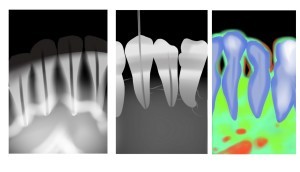
In the past, dentists had to use film x-rays in order to get a good look at your teeth and jaw. These traditional methods required far greater exposure to radiation for the patient, and a number of toxic and caustic chemicals needed to be mixed and stored in your dentist’s office. Today, digital x-rays provide both a safer and faster way for your dentist to assess your overall oral health. This is excellent for patients who don’t have a lot of time to wait for x-rays to develop, and for busy dental offices who want to take care of their patients as quickly as possible.
Using digital x-rays eliminates the need for dangerous film development chemicals in your dentist’s office, and requires 90% less exposure to radiation. Your dentist or their dental assistant will place a miniature camera inside your mouth where it will take pictures of the bone structure surrounding your teeth, the teeth and teeth structure, roots and your gums. There is no wait while the x-rays are developed; your dentist can view the x-rays almost immediately. This allows for faster identification of any oral health issues that may need correction, allowing us to treat you far more quickly than more traditional x-ray methods. In addition, you may be able to view your x-rays right along with your dentist, leading to more open discussion between dentist and patient, and giving you a more thorough understanding of your own oral and dental health.
Benefits of Digital X-Rays
One of the largest benefits of digital x-rays is that making copies for dental records and insurance purposes is much easier. This allows us to notify your insurance company more quickly of issues requiring treatment getting you approved for the necessary coverage as soon as possible. Waiting for dental treatments can be uncomfortable and even painful; digital x-rays can help cut down on that time, ensuring that we can get your smile back to its healthiest state as soon as possible.
If you have questions on our use of digital x-rays, or for more information, please call the office of Dr. Albert Ehrhardt today at 940-592-9880 for a consultation. Our helpful and friendly staff will be happy to answer any questions you might have about our process and procedures for taking x-rays.
Dental X-Rays
Dental radiographs (x-rays) are essential, preventative, diagnostic tools that provide valuable information not visible during a regular dental exam. Dentists and dental hygienists use this information to safely and accurately detect hidden dental abnormalities and complete an accurate treatment plan. Without x-rays, problem areas may go undetected.
Dental x-rays may reveal:
• Abscesses or cysts.
• Bone loss.
• Cancerous and non-cancerous tumors.
• Decay between the teeth.
• Developmental abnormalities.
• Poor tooth and root positions.
• Problems inside a tooth or below the gum line.
Detecting and treating dental problems at an early stage can save you time, money, unnecessary discomfort, and your teeth!
Are dental x-rays safe?
We are all exposed to natural radiation in our environment. The amount of radiation exposure from a full mouth series of x-rays is equal to the amount a person receives in a single day from natural sources.
Dental x-rays produce a low level of radiation and are considered safe. Dentists take necessary precautions to limit the patient’s exposure to radiation when taking dental x-rays. These precautions include using lead apron shields to protect the body and using modern, fast film that cuts down the exposure time of each x-ray.
How often should dental x-rays be taken?
The need for dental x-rays depends on each patient’s individual dental health needs. Dr Ehrhardt or one of our dental hygienist will recommend necessary x-rays based on the review of your medical and dental history, dental exam, signs and symptoms, age consideration, and risk for disease.
A full mouth series of dental x-rays is recommended for new patients. A full series is usually good for three to five years. Bite-wing x-rays(x-rays of top and bottom teeth biting together) are taken at recall (check-up) visits and are recommended once or twice a year to detect new dental problems.


